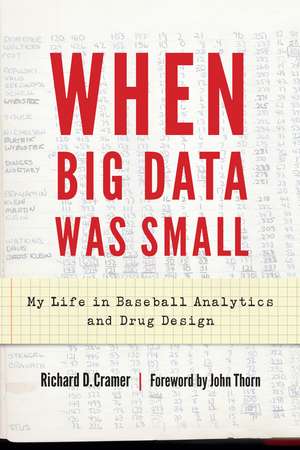When Big Data Was Small: My Life in Baseball Analytics and Drug Design
Autor Richard D. Cramer Cuvânt înainte de John Thornen Limba Engleză Hardback – 30 apr 2019
Richard D. Cramer has been doing baseball analytics for just about as long as anyone alive, even before the term “sabermetrics” existed. He started analyzing baseball statistics as a hobby in the mid-1960s, not long after graduating from Harvard and MIT. He was a research scientist for SmithKline and in his spare time used his work computer to test his theories about baseball statistics. One of his earliest discoveries was that clutch hitting—then one of the most sacred pieces of received wisdom in the game—didn’t really exist. In When Big Data Was Small Cramer recounts his life and remarkable contributions to baseball knowledge.
In 1971 Cramer learned about the Society for American Baseball Research (SABR) and began working with Pete Palmer, whose statistical work is credited with providing the foundation on which SABR is built. Cramer cofounded STATS Inc. and began working with the Houston Astros, Oakland A’s, Yankees, and White Sox, with the help of his new Apple II computer.
Yet for Cramer baseball was always a side interest, even if a very intense one for most of the last forty years. His main occupation, which involved other “big data” activities, was that of a chemist who pioneered the use of specialized analytics, often known as computer-aided drug discovery, to help guide the development of pharmaceutical drugs. After a decade-long hiatus, Cramer returned to baseball analytics in 2004 and has done important work with Retrosheet since then. When Big Data Was Small is the story of the earliest days of baseball analytics and computer-aided drug discovery.
In 1971 Cramer learned about the Society for American Baseball Research (SABR) and began working with Pete Palmer, whose statistical work is credited with providing the foundation on which SABR is built. Cramer cofounded STATS Inc. and began working with the Houston Astros, Oakland A’s, Yankees, and White Sox, with the help of his new Apple II computer.
Yet for Cramer baseball was always a side interest, even if a very intense one for most of the last forty years. His main occupation, which involved other “big data” activities, was that of a chemist who pioneered the use of specialized analytics, often known as computer-aided drug discovery, to help guide the development of pharmaceutical drugs. After a decade-long hiatus, Cramer returned to baseball analytics in 2004 and has done important work with Retrosheet since then. When Big Data Was Small is the story of the earliest days of baseball analytics and computer-aided drug discovery.
Preț: 160.01 lei
Nou
Puncte Express: 240
Preț estimativ în valută:
30.62€ • 32.74$ • 25.53£
30.62€ • 32.74$ • 25.53£
Carte disponibilă
Livrare economică 27 martie-10 aprilie
Preluare comenzi: 021 569.72.76
Specificații
ISBN-13: 9781496212054
ISBN-10: 1496212053
Pagini: 256
Ilustrații: 9 illustrations, 1 appendix, index
Dimensiuni: 152 x 229 x 26 mm
Greutate: 0.5 kg
Editura: Nebraska
Colecția University of Nebraska Press
Locul publicării:United States
ISBN-10: 1496212053
Pagini: 256
Ilustrații: 9 illustrations, 1 appendix, index
Dimensiuni: 152 x 229 x 26 mm
Greutate: 0.5 kg
Editura: Nebraska
Colecția University of Nebraska Press
Locul publicării:United States
Notă biografică
Richard D. Cramer started analyzing baseball statistics in the mid-1960s, after graduating from Harvard and MIT, and by 1969 he had discovered (or reinvented) the metric now known as OPS. He is the co-founder of STATS Inc. and has done important work with both SABR and Retrosheet. John Thorn is the official historian for Major League Baseball and the author of Baseball in the Garden of Eden.
Cuprins
Contents
Foreword by John Thorn
Acknowledgments
Introduction
1. Setting the Stage
2. Baseball and Science Surface
3. College
4. Graduate School and the 1960s Computer
5. Industrial Synthetic Chemist
6. Harvard’s Research Computer
7. Computer-Aided Drug Discovery
8. Sabermetrics’ Infancy
9. Scientific Recognition
10. Twists of Fate
11. Birth of STATS Inc.
12. White Sox and Yankees
13. Scientific Career Transition
14. Rebirth of STATS Inc.
15. Comparative Molecular Field Analysis
16. STATS Soars
17. Cheerlessness and Lyme Disease
19. The Rise and Fall of TRPS
19. Repudiated by STATS
20. Tidying Up
21. In My Humble Opinion
22. Summing Up
Appendix: Bamberg Mathematical Analysis of Baseball
Notes
Bibliography
Index
Foreword by John Thorn
Acknowledgments
Introduction
1. Setting the Stage
2. Baseball and Science Surface
3. College
4. Graduate School and the 1960s Computer
5. Industrial Synthetic Chemist
6. Harvard’s Research Computer
7. Computer-Aided Drug Discovery
8. Sabermetrics’ Infancy
9. Scientific Recognition
10. Twists of Fate
11. Birth of STATS Inc.
12. White Sox and Yankees
13. Scientific Career Transition
14. Rebirth of STATS Inc.
15. Comparative Molecular Field Analysis
16. STATS Soars
17. Cheerlessness and Lyme Disease
19. The Rise and Fall of TRPS
19. Repudiated by STATS
20. Tidying Up
21. In My Humble Opinion
22. Summing Up
Appendix: Bamberg Mathematical Analysis of Baseball
Notes
Bibliography
Index
Recenzii
"When Big Data Was Small is one of the most consequential books on baseball history and the evolution of thinking on the game."—Jason Schott, Brooklyn Digest
“Dick was one of a handful of people back in the 1970s who started the statistical revolution in baseball . . . in his spare time. He was also a respected scientist with a distinguished career, and he played a little jazz on the side. This book chronicles his life, with its ups and downs, both professional and personal, in an honest and unassuming way. It is an interesting journey, with the last chapter yet to be written.”—Pete Palmer, coauthor of The Hidden Game of Baseball: A Revolutionary Approach to Baseball and Its Statistics




















